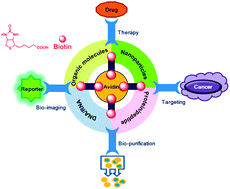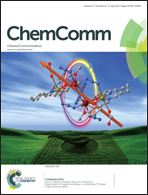Recent development of biotin conjugation in biological imaging, sensing, and target delivery
Abstract
Despite encouraging results from preliminary studies of anticancer therapies, the lack of tumor specificity remains an important issue in the modern pharmaceutical industry. New findings indicate that biotin or biotin-conjugates could be favorably assimilated by tumor cells that over-express biotin-selective transporters. Furthermore, biotin can form stable complexes with avidin and its bacterial counterpart streptavidin. The strong bridging between avidin and biotin moieties on other molecules is a proven adaptable tool with broad biological applications. Under these circumstances, a biotin moiety is certainly an attractive choice for live-cell imaging, biosensing, and target delivery.


 Please wait while we load your content...
Please wait while we load your content...